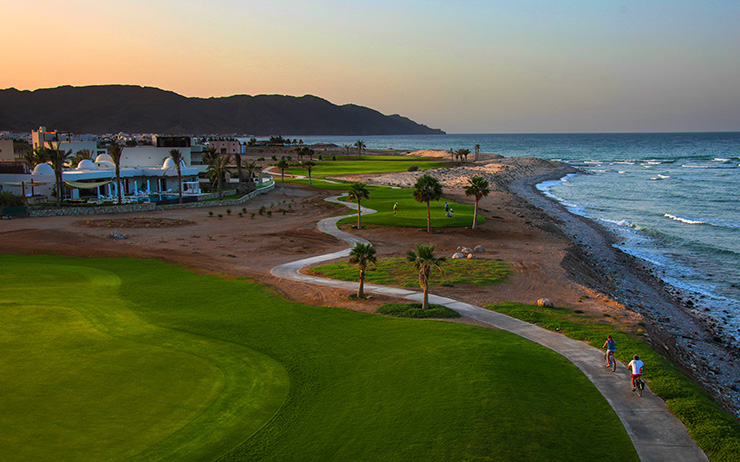By Kent Gray
The latest addition to the Middle East’s enviable course portfolio offers a refreshing alternative to the “monster championship” layouts that predominate the region’s golfing landscape.
Jebel Sifah GC is the 9-hole epicentre of a seaside and yacht-dotted residential/resort community by the same name, 65km south-east of Muscat, Oman’s capital city.
To be managed by Troon International, the desert-links was designed by Harradine Golf whose principal architect Peter Harradine is the antithesis of many of today’s contemporary course designers.

The 5th green
While developers elsewhere continue to be delivered overly difficult behemoths in a foolhardly attempt to lure tour events and/or to future proof their investment against the advances of club and ball technology, Harradine’s design philosophy has long focused on the physical ability (or relative lack thereof) and potential enjoyment of “average players”
The first pictures of Jebel Sifah, obtained exclusively by Golf Digest Middle East just after the course’s soft opening, clearly illustrate the fun factor Harradine desires.

Stunning Gulf of Oman views across the 6th green
Wide fairways, large greens and the absence of “useless” fairway bunkers promise aesthetically-pleasing, resort-style golf where the natural topography has been cleverly enhanced to offer strategic challenge.
The par 36 layout, which can be stretched from its forward-most tees at 2843 yards to a championship standard 3634 yards from the tips, is easily able to be toughened with greens that offer “easy, difficult and very difficult pin positions.” The use of a second set of pins on each of the nine greens can also transform the course into a par 72, 18-holer.
Sweeping Gulf of Oman views, natural wadis and a majestic mountain range backdrop complete the alluring picture at Harradine Golf’s first seaside offering.
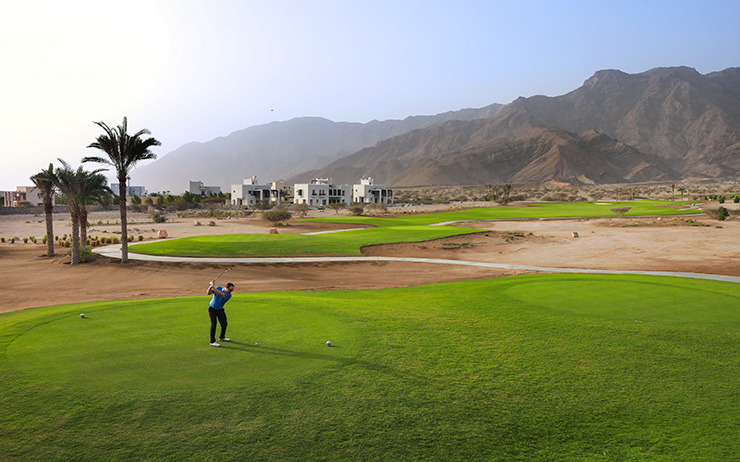
The 1st tee leads the eye towards the majestic mountain range
“Surprisingly and for once, the client did not want a monster ‘championship’ layout but a resort course that would be fun for average players that are, after all, the back bone of the golf industry,” Harradine Golf said.
“Two holes play towards or along the Indian Ocean [Gulf of Oman] and the nearby mountains provide a dramatic and constant back drop. Play is also interesting thanks to a continuous breeze from the sea that often changes direction which obliges difficult club selection [decisions] and playing strategy.
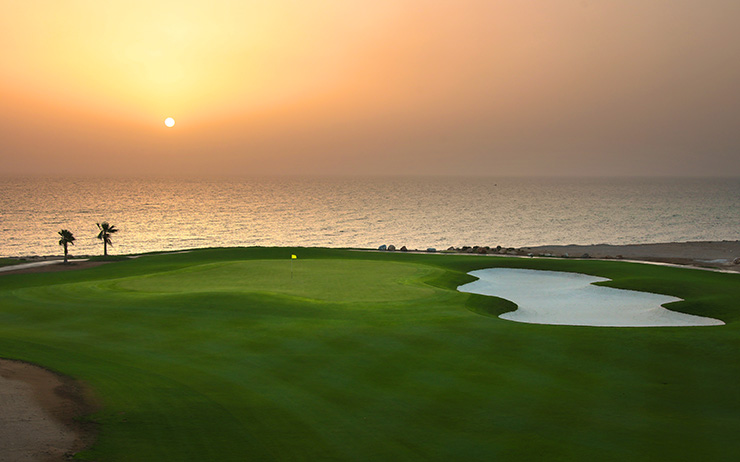
“Despite the topography, the course is rather flat and a pleasure to walk which is not always the case with courses on real estate projects as they often have great distances between the greens and the next tees.”
Harradine Golf praised the developer, Muriya (a joint venture between Orascom Development Holding and Omani master developer Omran) for heeding its recommendations regarding the safety limits of the real estate that fringes the course.
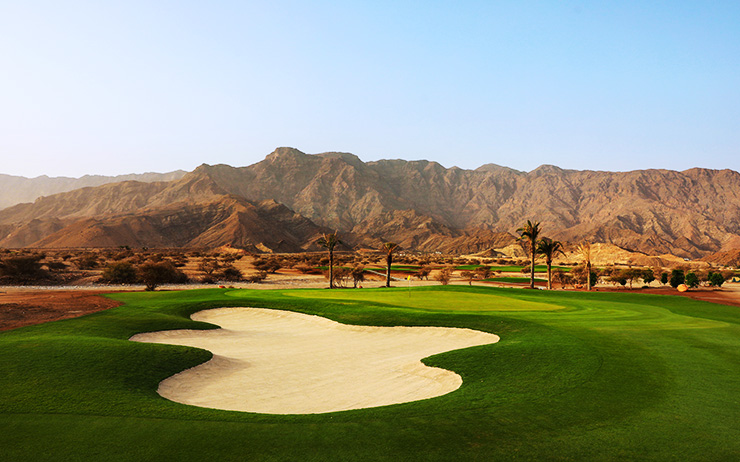
There are no fairway bunkers but challenging traps around the greens
“The stylish houses are therefore unobtrusive around the course as it meanders through and around wadis which are filled with torrential water during the few but violent rain-falls. The complete sub-surface is composed of big and small caliber gravel which ensures rapid drainage during those storms. “
Jebel Sifah is the latest addition to Harradine Golf’s Middle East portfolio which includes European Tour venues Abu Dhabi Golf Club, Doha Golf Club (Qatar) and Al Hamra GC (Ras Al Khaimah/Challenge Tour) plus Jebel Ali Golf Resort (Dubai), Sharjah Golf & Shooting Club and Mirage City Golf Club in Egypt.
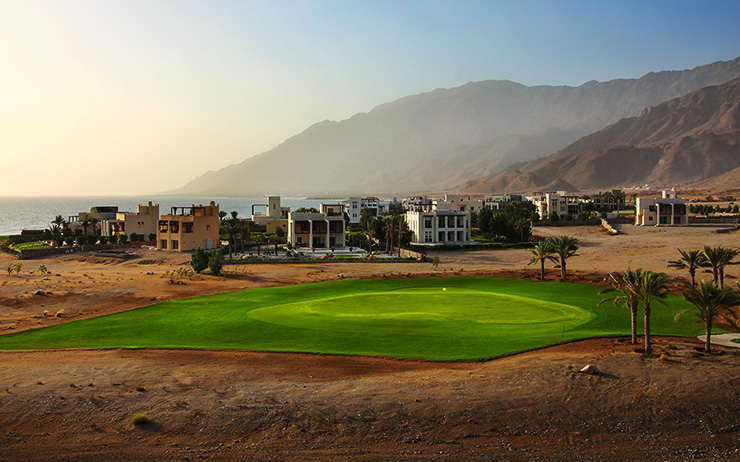
The 8th green
Set along five kilometres of natural Omani coastline and spanning 6.2 million square metres, Jebel Sifah is home to one luxury hotel and has five more in planning. Able to be reached by water taxi from Muscat, the resort also includes “Golf Lake Villas” and marina apartments which can be owned freehold by Omanis and expats.
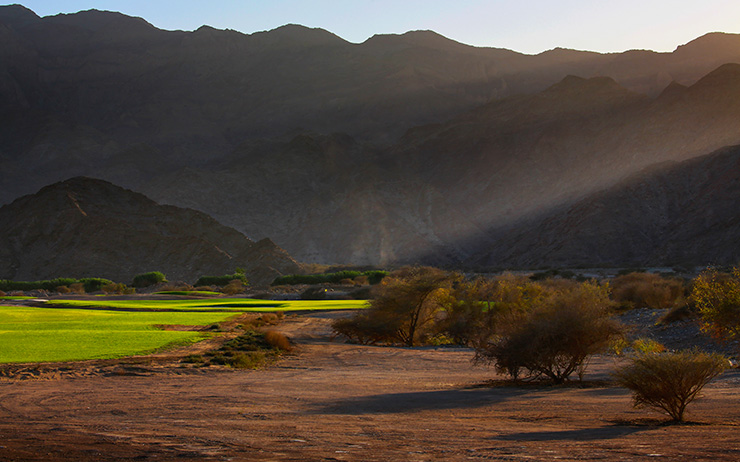
The second hole bathed in late evening sunlight

